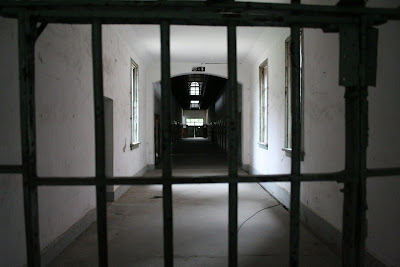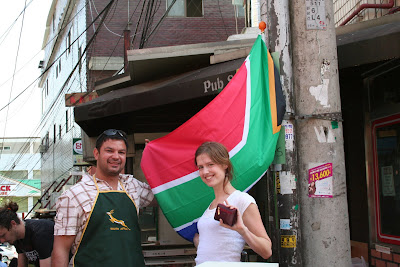Seodaemun Prison
Inside the History Hall of (what is left of) Seodaemun Prison
The prison was designed according to a Japanese prison design style. For maximum control over the prison, three cell blocks (or rectangles) flare out from a single central control point.
Prison life
In northern Seoul, a tall red brick watchtower rises above an urban area of modern businesses, homes and a subway stop.
Seodaemun prison, a century-old relic of the Japan colonization and terrorization of Korea, uncomfortably tries to blend in with the sprawling city that surrounds it.
It is here where, a hundred years ago, the Japanese imprisoned, tortured and executed Koreans.
In the early 1900's members of the Korean Independence Movement were working hard to gain Korea's independence. The Japan colonists didn't agree with this rebelliousness. They built dozens of prisons throughout the Korean peninsula - remember, this was before Korea was split in two.
Seodaemun Prison, in northeast Seoul, housed some 40 000 Koreans who were part of the Korean Independence Movement. As the prisons filled up, prisoners were crammed into tiny rooms. Sometimes 7-8 prisoners shared one cell. The cells had one small window, no toilet.
About 400 of these prisoners didn't survive their time in captivity - most starved to death. Thousands others survived, but with permanent damage to their health.
From schoolgirl to heroin
An orphaned 20-year old Korean girl became one of the most famous former-inmates of Seodaemun prison. Ryu, Gwan-sun's parents were killed by the Japanese. In 1919 she was arrested for protesting with the Korean Independence Movement at Aunae Marketplace. She was first imprisoned in Gonju Prison before being moved to Seodaemun. Shortly after being imprisoned Gwan-sun rallied fellow prisoners into a full-scale prison demonstration against the Japanese. Gwan-sun was moved to solitary confinement in an underground cell, where she was tortured and starved.
You'd think a girl who, at a young age as this could already inspire people to follow her and rise up against their suppressors, would have a bright future ahead of her once Korea gained independence. Unfortunately, the Japanese tortured Ryu, Gwan-sun to death in 1920.
With a rich, heroic history such as this, Seodaemun could offer an emotional visit to tourists and Koreans, alike. But the prison has lost much of it's sense of realism and has gained a sense of absurdism and the macabre.
While the red brick buildings still look much as they would've looked 90 years ago, this is only on the outside. And althought the wailing tree outside the execution building tells you more of the suffering of Koreans than any re-enacted video could ever do, this is not enough to save the experience from being over-the-top.
Lifesize puppets resembling inmates have arms and heads that move with robotic grace. Tape recorded screams sound from speakers as you walk past these puppets who are in the act of being tortured by a Japanese puppet. Pink blood is splattered over the cell wall, the puppet's hair is out of place and patchy and their faces are frozen in expressions of agonizing pain.
The video hall shows a re-enactment of how the Japanese tortured Korean inmates. The Japanese guy screams and cracks his whip (so to speak) a lot, and gives an evil cackle as he flips the switch to electrocute the Korean who's already bleeding from his nose and ears.
There's also a room where you can experience "torture". In a dark the room you sit on a small wooden chair, stare into a small hole that looks into a dimly lit room where a woman (puppet) is bent over double in pain. Blood stains on her clothes. And then the tape recorded screaming starts. A few seconds later the lights go on, the screaming stops and you feel a little queasy and well, tortured. But not for the right reasons.
The museum is well worth a visit, if you can look past the fairground attractions and rather focus on the historic aspect. It is also cheap, getting you a full pass for $1,50. See the bottom of this article for more visitor information.
The watchtower and red brick wall of the prison enclosure.
 The female inmates were imprisoned in these underground solitary cells. Inmates were interrogated and tortured here - these cells were named Ryu Gwan-sun cells after the independence movement's heroin.
The female inmates were imprisoned in these underground solitary cells. Inmates were interrogated and tortured here - these cells were named Ryu Gwan-sun cells after the independence movement's heroin.
 The wailing tree outside the execution house. On the way to their death, prisoners would hold on to this tree crying, before being dragged off to the house where they were hanged. A hidden tunnel behind the house was used to secretly dispose of the bodies.
The wailing tree outside the execution house. On the way to their death, prisoners would hold on to this tree crying, before being dragged off to the house where they were hanged. A hidden tunnel behind the house was used to secretly dispose of the bodies.
VISITORS
Opening hours: Mar - Oct, 09:30 - 18:00
Nov - Feb, 09:30 - 17:00
Closed on New Year's Day, Full-moon festival, and every Monday (if the Monday is a public holiday, then the museum is closed the following day).
Get there: Take line 3 (Orange line) to Dongnimmun station, exit 5. Walk straight for two minutes. The prison and Independence park is on your left.
http://www.sscmc.or.kr/















































